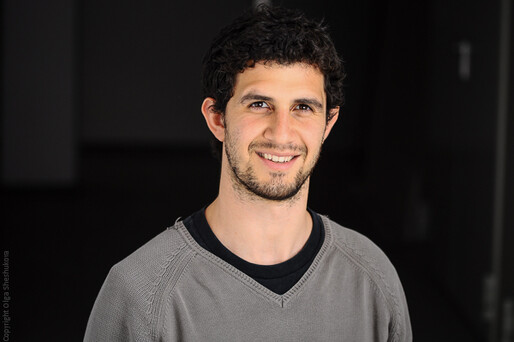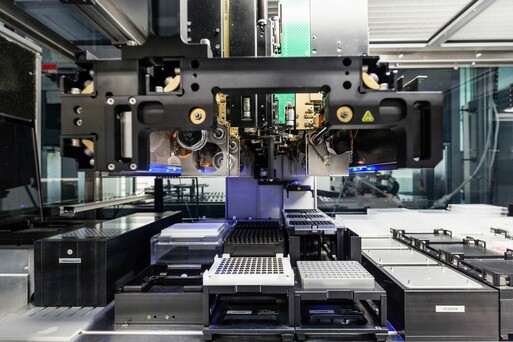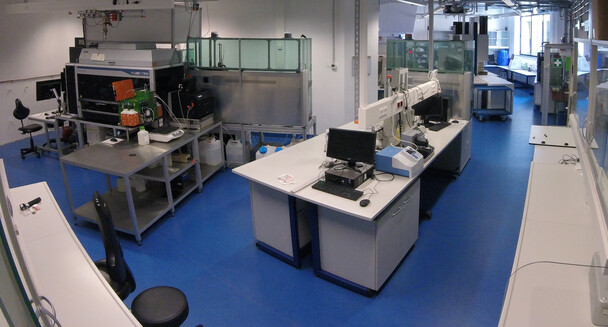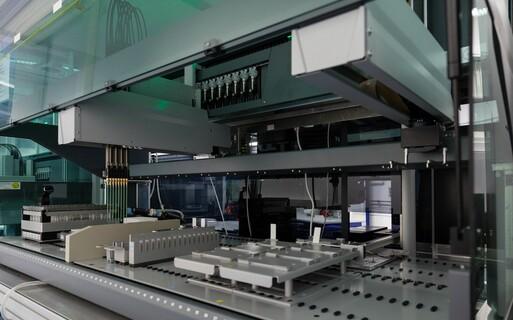Because they can do it better – robot systems in biotech : Date: , Theme: International Future Labs
Nicolas Cruz has great belief in what people can do. He says they are still smarter and more precise than robots. But what people cannot do is conduct thousands of biotech experiments at the same time. Which is why he wants to let machines do this task.
We all know about robot vacuum cleaners. Self-operating systems like these come in all shapes and sizes. These intelligent machines, devices or software systems carry out various specific tasks on their own. They have already become established in many sectors, but not yet in one of our key technologies, biotechnology. Dr. M. Nicolas Cruz-Bournazou, a chemical engineer who is the Project Leader of the KIWI-biolab, wants to change all that together with a team of 31 experienced researchers. He sees his most important task in bringing together the different scientists to work on this project. The team’s vision is that, if robots operated biotechnological experiments themselves, the resulting products and medical drugs could be produced more cheaply, abundantly and sustainably.

The project was made possible with funding from the Federal Ministry of Education and Research. Since May 2020, KIWI-biolab researchers from South Korea, Vietnam, Russia, Austria, Germany, the USA and Argentina have been working to advance biotechnology using intelligent robot systems. What makes the team special is that its members, who come from a wide range of disciplines including biotechnology, mathematics, computer science and bioprocess engineering, work together across disciplinary boundaries. The KIWI-biolab is located at the Department of Bioprocess Engineering at the Technische Universität Berlin.
Heat, acid and air provide the right conditions for cells to grow
Products of biotechnological processes are part of our everyday lives and include washing detergents, medical drugs and yoghurt. They are produced using living cells from fungi, plants and animals. Within these cells, microorganisms such as bacteria set off thousands of biochemical reactions leading to the formation of large and complex proteins with perfect structures. Ideally, this creates a substance that can be used in medicine, chemistry or agriculture. The end products created by the KIWI-biolab are mostly proteins (biopolymers), biodiesel or medical drugs.
The clean water produced in sewage treatment plants is also the product of these bioactive processes. Dr. Cruz-Bournazou uses this example to explain the principle of biotechnology. “The wastewater is the nutrient medium, because it contains various organic-biological and chemical substances. Bacteria feed on these substances and multiply, thereby turning the sludge into pure water.” This degradation works especially well under certain conditions. Important roles are played by nitrogen content, oxygen supply, temperature or pH value. With the help of high-throughput methods, researchers can test the growth of thousands of organisms under various conditions and find out which influences are especially conducive for producing certain products.
“A typical application using a high-throughput method would be to use various methods to genetically modify Escherichia-Coli bacteria found in our intestinal flora. After that we would test all the bacteria in order to find out which of the organisms have survived, which display good growth, and which produce exactly what we need.”

The self-driving biotech box
High-throughput tests are time-consuming and expensive. This is where the KIWI-biolab team comes in. It makes use of machine learning, which is a branch of artificial intelligence. Robots already carry out biotechnology experiments. However, these only involve individual steps like pipetting, while it is still people who analyse the test results. They look at the data and consider what needs to be done differently in the next experiment. The robots must then simply wait or carry out suboptimal experiments until the scientists have set up the next experiment.
The idea of the KIWI-biolab team is that robot systems should start analysing the data with the help of algorithms as soon as it emerges during the experiment and then take the right decisions themselves for the next tests, for example regarding temperature or pressure, and ultimately also plan and conduct the next experiment. This will enable people involved in the analysis and planning of experiments to process large amounts of data and decision variables without delay. This means no more waiting between experiments. Another issue is that it is difficult for the researchers to plan more than 40 experiments at a time. “For robot systems, 1,000 tests or more are just a matter of computing capacity,” explains Cruz-Bournazou. But people who think that there will be humanoid robots moving around the lab have the wrong idea. “It is really a large box that can run a high number of biotechnology experiments at the same time,” he says.

Linking small and large scale using AI
The KIWI-biolab team first wants to test the fully automated process with different substances. “In this way, we want to prove the universal applicability of our approach,” says Cruz-Bournazou. What the researchers also have in mind is scaling up. One of the major challenges of biotechnological process development so far is to design the process conditions in the lab so that they can provide a profitable and more sustainable alternative to existing production technologies also in the case of large bioreactors working under industrial conditions. “A reactor can be the size of a house, big enough to contain large stirrers and where many energy and substance transport processes take place.”
One important focus of the lab is to link the different scales – laboratory and bioreactor scale – with the aid of machine learning in such a way that new substances can be developed as efficiently as possible. AI processes are already applied in the search for new substances. Virtual screening, for example, involves a programme searching through multiple molecule libraries and evaluating the probability of their forming bioactive structures – or it searches for the most suitable enzymes for the chemical reactions. “The typical virtual screening applications that so far exist only work with very small screening amounts and stop as soon as the best protein is identified. So they don't get as far as defining culture growth at bioreactor level,” explains Dr. Cruz-Bournazou.
The KIWI-biolab wants to close this gap. “This would give biotechnology a major boost,” he says, adding that the environment would be a major beneficiary. This is because bioprocesses usually take place under milder and more sustainable conditions than chemical processes and often generate products that are biodegradable such as bioplastics.

In the future: more biotech, less chemistry?
Could biotech processes even replace traditional methods of chemical production? This question is a constant topic of discussion among the KIWI-biolab team. Chemical production still has a major advantage. It can be developed more easily and safely because the processes are much better known. As Cruz-Bournazou says, “Today it is common practice to develop a chemical product almost exclusively using computer simulations and then to carry out a few tests on a larger scale and to set up production at any location.” But it is not as straightforward with living cells. For example, a change of production location would mean a change in the quality of the available water and grain, which is a component of the nutrient medium. In a biotechnology process, these variations would cause major differences in the end product.
Cruz-Bournazou is convinced that intelligent robot systems can provide the necessary help: “If we can make biotechnology development a little more stable, faster and robust by using computer-aided methods, robots, machine learning and AI, we can get a lot closer to chemical production.” The KIWI-biolab scientists believe that biotech production can make industry more sustainable in the long term. This would not only be an important contribution to sustainability and CO2 reduction. Dr. Cruz-Bournazou might then have a little more time for the joint research that he really wants to do with real people and definitely not leave to machines.
